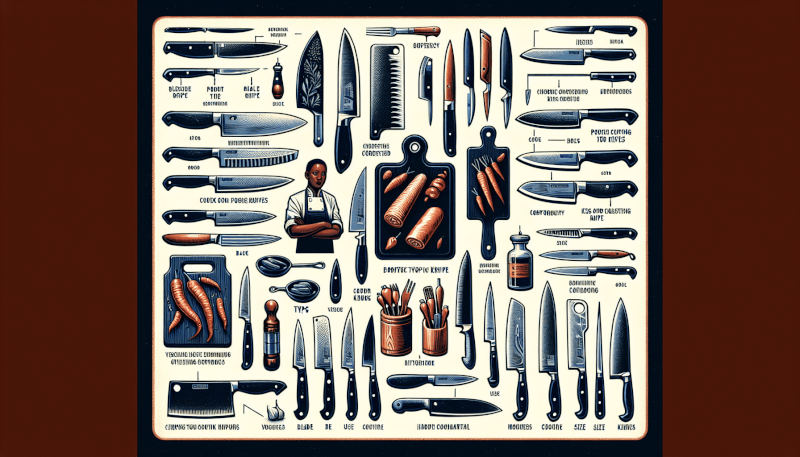Are you a cooking enthusiast looking to upgrade your kitchen tools? Choosing the right knife for cooking can make a world of difference in your culinary journey. With a plethora of options available, it can be overwhelming to know where to begin. Fret not, as we are here to guide you through the process of selecting the perfect knife that will become your trusted companion in the kitchen. From understanding different types of knives to considering factors like blade material and handle design, we will provide you with all the necessary information to make an informed decision. Get ready to slice and dice like a pro!

Types of Knives
Chef’s Knife
The chef’s knife is a versatile and essential tool in every kitchen. With its broad and sharp blade, it can handle a variety of cutting tasks, including chopping, slicing, and dicing. The length of a chef’s knife typically ranges from 6 to 12 inches, with the most common size being 8 inches. This knife is perfect for most home cooks and professional chefs alike.
Paring Knife
The paring knife is a small and nimble knife that is perfect for precision tasks. Its narrow blade allows for intricate cutting, trimming, and peeling. A paring knife is typically around 3 to 4 inches in length. Whether you’re coring strawberries or carving delicate designs on vegetables, a paring knife is an essential tool for any kitchen.
Serrated Knife
The serrated knife, sometimes called a bread knife, is characterized by its saw-like edge. This edge is excellent for cutting through tough-skinned foods like bread and tomatoes without crushing or tearing them. The length of a serrated knife can vary, but the most common size is around 8 to 10 inches. If you frequently deal with crusty bread or delicate fruits, a serrated knife is a must-have in your kitchen.
Boning Knife
As the name suggests, a boning knife is primarily used for removing bones from meat, poultry, and fish. With its narrow and flexible blade, it can easily maneuver around joints and separate meat from bones with precision. Boning knives usually range from 5 to 7 inches in length. If you often handle meat preparation, a boning knife will greatly assist you in this task.
Utility Knife
The utility knife is a smaller version of the chef’s knife and is used for various light and medium-duty tasks. Whether you’re preparing sandwiches, slicing small vegetables, or trimming meat, the utility knife offers versatility and control. Utility knives typically have blades around 4 to 6 inches long. This all-purpose knife is a great addition to any kitchen, especially for those who don’t need a full-sized chef’s knife.
Santoku Knife
The Santoku knife is a Japanese knife that has gained popularity worldwide. It features a shorter and wider blade compared to a chef’s knife, offering excellent precision and control. Santoku knives are ideal for slicing, dicing, and chopping fruits, vegetables, and boneless meats. The length of a Santoku knife is usually 5 to 7 inches. If you appreciate the elegance and efficiency of Japanese knives, a Santoku knife should be on your radar.
Carving Knife
A carving knife is specifically designed for slicing cooked meats, such as roasted turkey or prime rib. With its long, narrow blade, it effortlessly glides through meats, creating thin and even slices. Carving knives typically have blades that are 8 to 12 inches long, making them perfect for special occasions or holiday feasts.
Bread Knife
Similar to a serrated knife, a bread knife is essential for slicing through bakery items without squashing or tearing them. Its long, serrated blade makes cutting through crusty bread, bagels, or pastries a breeze. Bread knives come in various lengths, but a common size is around 8 to 10 inches. If you’re a bread lover or frequently work with baked goods, a bread knife is a necessary tool in your kitchen.
Cleaver
The cleaver is a heavy-duty knife that excels in tasks that require significant force, such as splitting bones or chopping through thick cuts of meat. Its broad and thick blade is perfect for pounding garlic or tenderizing meat as well. Cleavers vary in size and weight, but they typically have blades ranging from 6 to 8 inches in length. If robust and powerful chopping is part of your cooking routine, a cleaver is an excellent addition to your knife collection.
Filleting Knife
A filleting knife is designed for delicate tasks like filleting and deboning fish. With its thin, flexible blade, it easily maneuvers through the contours of the fish, ensuring clean and precise cuts. Filleting knives have blades that typically range from 6 to 9 inches in length. If seafood preparation is a regular part of your culinary adventures, a filleting knife will elevate your skills and efficiency in the kitchen.
Blade Material
Stainless Steel
Stainless steel is the most common blade material found in kitchen knives. It is durable, resistant to corrosion, and requires minimal maintenance. Stainless steel knives are generally affordable and provide excellent value for money. While they may not hold their sharp edge as long as other materials, stainless steel blades are versatile and suitable for a wide range of kitchen tasks.
Carbon Steel
Carbon steel blades are known for their exceptional sharpness and ability to maintain their edge. They are easy to sharpen and offer superior cutting performance. However, carbon steel is susceptible to rust and requires careful cleaning and maintenance to prevent discoloration and corrosion. If you prioritize sharpness and cutting efficiency, a carbon steel knife might be the perfect choice for you.
High-Carbon Stainless Steel
High-carbon stainless steel blades combine the best of both worlds. They offer the durability and corrosion resistance of stainless steel with the superior sharpness and edge retention of carbon steel. These blades are less prone to rusting than carbon steel knives, making them more low-maintenance. High-carbon stainless steel knives are widely popular due to their balance of performance and convenience.
Ceramic
Ceramic blades have gained popularity in recent years due to their exceptional hardness and sharpness. They are incredibly lightweight and retain their edge remarkably well. Ceramic knives are non-reactive, meaning they won’t affect the taste or smell of food. However, they are also more brittle than other types of blades, making them susceptible to chipping or breaking if mishandled or dropped. If you handle delicate fruits and vegetables or desire a long-lasting sharp edge, a ceramic knife is worth considering.

Blade Length
8-Inch
An 8-inch blade is the most popular size for chef’s knives and offers the perfect balance between versatility, control, and maneuverability. It is suitable for most cutting tasks, from slicing and dicing to chopping and mincing. An 8-inch blade is an excellent choice for both professional chefs and home cooks.
6-Inch
A 6-inch blade is slightly smaller than the standard 8-inch chef’s knife. It provides better maneuverability and control for those with smaller hands or those who prefer a lighter knife. A 6-inch blade is ideal for tasks that require finesse and precision, such as peeling and trimming.
10-Inch
A 10-inch blade is preferred by chefs who require extra length and cutting power. This size is commonly used for large cuts of meat, such as roasts or whole poultry. However, a 10-inch blade may feel unwieldy for those with smaller hands or less experience in the kitchen. If you frequently handle large cuts of meat or prefer a longer blade, a 10-inch knife might be suited to your needs.
Blade Shape
Straight Edge
A straight edge blade is the most common and versatile blade shape. It features a straight cutting edge from the base to the tip, allowing for precise slicing and chopping. Straight edge blades are suitable for a wide range of kitchen tasks and provide excellent control and accuracy.
Curved Edge
A curved edge blade, also known as a “belly” or “rocking” blade, has a slight curve along its cutting edge. This shape facilitates a rocking motion during cutting, making it ideal for tasks such as mincing herbs or chopping vegetables. A curved edge blade enables efficient and continuous cuts with minimal effort.
Granton Edge
A Granton edge blade features small indentations, also known as hollow-ground ovals, that run along the length of the blade. These indentations reduce friction and prevent food from sticking to the blade while cutting. A Granton edge is commonly found on slicing knives and is particularly useful when cutting thin slices of meat or fish.

Handle Material
Wood
Wooden handles offer a timeless and traditional aesthetic to knives. They provide a warm and comfortable grip, offering excellent control and maneuverability. However, wooden handles require more careful maintenance to prevent moisture damage or bacterial growth. If you value the natural beauty and tactile feel of wood, a knife with a wooden handle might be the perfect choice for you.
Plastic
Plastic handles are lightweight, durable, and easy to clean. They are often cost-effective and are available in various colors and shapes. Plastic handles are suitable for those seeking a low-maintenance option that offers a secure grip. However, they may not offer the same level of elegance or longevity as other handle materials.
Stainless Steel
Stainless steel handles provide a sleek and modern look to knives. They are highly durable, resistant to corrosion, and easy to clean. Stainless steel handles are often hollowed out or feature textured patterns to enhance grip. However, stainless steel handles may feel cold or slippery when wet, so it’s essential to consider your comfort and grip preferences.
Composite Material
Composite handles combine different materials, such as wood and plastic, to offer the best of both worlds. They provide the durability and moisture resistance of plastic with the aesthetic appeal of wood or other materials. Composite handles often offer excellent grip and ergonomic designs, making them comfortable to hold and use for extended periods.
Handle Length and Grip
Full Tang
A full tang handle refers to a knife where the blade extends fully into the handle, providing strength, balance, and stability. The handle material is attached to the two sides of the tang, offering a secure and comfortable grip. Full tang knives are known for their robust construction and durability and are often preferred by professional chefs and knife enthusiasts.
Rat-Tail Tang
A rat-tail tang handle features a thin extension of the blade into the handle, resembling a rat’s thick tail. This style of tang is commonly found in lower-quality knives and is less sturdy than a full tang. Knives with a rat-tail tang may feel unbalanced and less reliable, making them less suitable for heavy-duty tasks or frequent use.
Partial Tang
A partial tang handle has a blade extension that does not reach the full length of the handle. This style of tang is often found in lighter and more compact knives, such as paring or utility knives. The handle is typically attached to the exposed tang section, providing enough stability for everyday kitchen tasks. However, knives with a partial tang may not offer the same level of durability and strength as full tang knives.
Handle Grip
The grip of a knife handle plays a crucial role in providing comfort and control during use. Handles come in various shapes and sizes, including ergonomic contours, textured patterns, or customized designs. It’s essential to choose a handle grip that feels comfortable and secure in your hand. Consider testing different handles to find the one that suits your grip style and enhances your overall cutting experience.

Weight and Balance
Heavy Knife
A heavy knife provides more weight, allowing the knife to do more of the work during cutting or chopping. The extra weight can make slicing through tough meats or root vegetables easier and more efficient. However, heavy knives require more effort to control, especially for intricate tasks that require precision and finesse.
Lightweight Knife
A lightweight knife offers excellent maneuverability and control, making it ideal for tasks that require precision and delicate cuts. These knives are also less fatiguing to use for extended periods. However, lightweight knives may not handle heavy-duty tasks as effectively, requiring more effort and multiple cuts to achieve desired results.
Tang Balance
In addition to the weight of the blade, balance plays a crucial role in knife performance. The balance point of a knife refers to the point on the blade where it rests on a finger when balancing it horizontally. Well-balanced knives offer optimal control and reduce strain on the wrist and arm during use. Finding a knife with the right balance for your cutting style is essential to enhance your comfort and cutting efficiency.
Maintenance and Care
Sharpening
Regular sharpening is essential to maintain the optimal performance of your knife. Choose a sharpening method that suits your needs and skill level, whether it’s using a sharpening stone, honing rod, or an electric sharpener. Follow the manufacturer’s guidelines for sharpening angles and techniques specific to your knife. Additionally, it’s crucial to regularly hone your knife with a honing rod to keep the edge aligned and extend the time between sharpenings.
Storage
Proper storage protects your knives from damage and maintains their sharpness. Consider using a knife block, magnetic strip, knife roll, or sheaths to store your knives safely and keep them easily accessible. Avoid storing knives loosely in drawers, as they can become dull or sustain damage from other utensils. Always clean and dry your knives thoroughly before storing them to prevent moisture-related issues.
Cleaning
Proper cleaning ensures the longevity and hygiene of your knives. Hand wash your knives immediately after use, using mild dish soap and warm water. Avoid soaking knives or leaving them in the sink, as prolonged moisture exposure can lead to rust or deterioration of the handle. Use a non-abrasive sponge or cloth to clean both the blade and handle, and dry them thoroughly before storage.

Budget
Set a Budget
Before purchasing a knife, it’s crucial to set a budget that aligns with your needs and preferences. Knives come in various price ranges, from budget-friendly options to high-end, professional-quality knives. Consider the frequency of use, the importance of performance, and the level of craftsmanship you desire to determine an appropriate budget for your knife.
Quality vs Price
While it’s tempting to solely focus on price when purchasing a knife, it’s essential to consider the quality and craftsmanship as well. Cheaper knives may not offer the same level of durability, sharpness, or precision as higher-quality knives. Investing in a higher-quality knife ensures longevity, superior performance, and overall satisfaction in the kitchen. Take the time to research and read reviews to find the best balance between quality and price within your budget.
Consider Your Cooking Style
Frequency of Use
Consider how frequently you cook and the types of tasks you regularly perform in the kitchen. If you are an avid cook who prepares meals from scratch every day, investing in a versatile, high-quality knife is recommended. For occasional cooks or those who rely on simpler preparations, a more budget-friendly knife may suffice. Understanding your cooking style and needs will guide you towards the right knife for your kitchen.
Types of Cuisine
Different cuisines often require specific cutting techniques and ingredient preparations. Consider the types of cuisine you enjoy cooking or aspire to explore. For example, if you frequently cook Asian dishes that involve precise slicing and delicate cuts, a Santoku knife may be more suitable. Understanding the requirements of your preferred cuisine or cooking style will help you choose a knife that complements your culinary endeavors.
In conclusion, choosing the right knife for your cooking needs involves considering various factors such as the type of knife, blade material, length, shape, handle material, grip, weight and balance, maintenance and care, budget, and personal cooking style. By understanding the different options available and how they align with your preferences and requirements, you can find a knife that enhances your culinary skills, efficiency, and enjoyment in the kitchen. So go ahead, explore the vast world of knives and find the perfect tool to elevate your cooking adventures!


